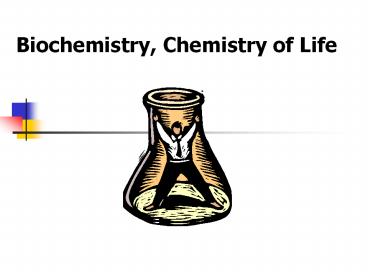Biochemistry, Chemistry of Life - PowerPoint PPT Presentation
Title:
Biochemistry, Chemistry of Life
Description:
Biochemistry, Chemistry of Life Living things are made from chemical compounds, so we must have a basic understanding of chemistry to study biology. – PowerPoint PPT presentation
Number of Views:313
Avg rating:3.0/5.0
Title: Biochemistry, Chemistry of Life
1
Biochemistry, Chemistry of Life
2
- Living things are made from chemical compounds,
so we must have a basic understanding of
chemistry to study biology.
3
Structure of the Atom
- Usually, there is an equal number of protons and
electrons so an atom is neutral.
4
What Is An Element?
- Pure substance consisting of only one type of
atom. - These are listed on the periodic table
5
What Is a Compound?
- A chemical combination of two or more elements
- For example if two hydrogen molecules are
combined with one oxygen molecule what is the
resulting compound?
- .
6
- Atoms in compounds are held together by chemical
bonds.
7
Covalent Bonds
- are formed when electrons are shared.
8
Ionic Bonds
- are formed when electrons are transferred from
one atom to another.
9
- The transfer of electrons results in an atom
either having a positive charge or a negative
charge. - These atoms with a charge are called ions.
10
Review
- 1.What are the three components of an atom?
- Protons, neutrons, and electrons
- 2.Which ones are in the nucleus of the atom?
- Protons and neutrons
- 3.Which ones are in the outer shell, and what
charge do they have? - Electrons (-)
11
- 4. What is an ionic bond?
- A chemical bond between atoms that is formed when
one or more electrons are transferred. - What is a covalent bond?
- A chemical bond formed when electrons are shared
between atoms.
12
What Is an Organic Compound?
- Compounds created within organisms, or living
things. - Lets look at the periodic table and do some
coloring
13
Some basic elements make up most organic
compounds
- Carbon.black
- Hydrogenyellow
- Oxygen.red
- Nitrogenblue
- Phosphorouspurple
- Calcium..green
- trace amounts
14
What are 4 Groups of Organic Compounds Found in
Living Things?
- Carbohydrates
- Lipids
- Nucleic Acids
- Proteins
15
Carbohydrates main source of energy
16
Lipids store energy
17
Nucleic Acids - contain genetics (DNA and RNA)
18
Proteins
- regulate cell processes, build bone and muscle,
help fight disease.
19
Properties of Water
- Water is the most abundant compound in most
living things. - Water is a polar molecule!!!!
20
What is Polarity?
- A molecule in which the charges are unequally
distributed. - For example, in the water molecule, the electrons
are more attracted to the nucleus of the oxygen
atom with 8 protons, than to the nucleus of the
hydrogen atom with only 1 proton. - This gives water some very unique properties.
21
Water has a bent shape due to Polarity
22
Acids and Bases
- Scientists devised a measurement system called
the pH scale to indicate the concentration of H
(hydrogen) ions in a solution. - Pure water has a pH of 7, which is neutral.
- Acids, have higher concentrations of H ions, and
a pH value below 7, while bases have lower
concentrations, and a value above 7.
23
(No Transcript)
24
- The pH of fluids in most cells in the human body
is between 6.5 and 7.5 - Controlling proper pH levels is important to
homeostasis. - Buffers are weak acids or bases that act to
regulate pH levels.
25
Chemical Reactions
- A process that changes one set of chemicals into
another . - The elements or compounds that enter into a
reaction are called the reactants. - The element or compound produced by the reaction
is called the product. - Reactions always require the breaking and forming
of bonds.
26
Energy
- Humans need to use energy to grow, think,
breathe, and even dream. - This release of energy we need, comes from the
chemical reactions that occur when we metabolize,
or break down food that we eat.
27
What Are Enzymes?
- Sometimes chemical reactions occur very slowly,
and need a catalyst to speed up the process. - Enzymes are proteins that speed up chemical
reactions that occur in cells.































